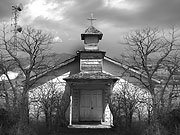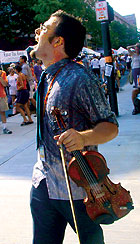
The spooky austerity of Hawthorne’s classic book, set in Puritan America, will be evoked by high-tech projection work.
|
“Everyone’s like, ‘Get a new color’ — especially my costumist,” laughs Terpsicorps Theatre of Dance Artistic Director Heather Maloy. Following last year’s darkly gothic performance of Masque of the Red Death, the dance troupe returns this summer with The Scarlet Letter, based on the Nathaniel Hawthorne novel regularly inflicted on unsuspecting high-school sophomores.
Like its predecessor, this performance is literary, deliciously morbid, uses projection work by local artist G. Craig Hobbs and, yes, features a shade of crimson.
But that’s pretty much where the similarities end.
“Masque was campy,” Maloy clarifies. “[Scarlet] is some of the most serious work I’ve ever done.”
But that doesn’t mean it’s a straightforward telling of the original story. Instead, this is Hawthorne’s Puritan New England re-envisioned in a kind of “Dark Angel” Armageddon of a future, with a full choir and music created by Rib Tips fiddler Ian Moore.
Says choir director Jenn Foster, “I call it Neo-Puritan punk.”
Homegrown music, interrupted

“I hate that novel!” exclaims Ian Moore. Nevertheless, the fiddler happily delved into the history of shape-note singing to score Terpsicorps Theatre of Dance’s Armageddon-flavored version of Scarlet Letter. photo by Steve Shanafelt
|
“I hate that novel,” insists Moore with a clear sense of relish. “All the characters are vapid and awful and can’t live with themselves.”
Still, while Maloy takes the visuals into a Mad Max-ian posterity, Moore had no problem reaching back 400 years for inspiration.
Because Terpsicorps’ version of Scarlet is set not in New England but in Appalachia, Moore turned to the spooky modalities of shape-note singing. “The basic melodies [that musicians] chose to set [shape-note hymns] to were borrowed from Elizabethan England,” he notes. “There are ballads that go back and back and back.”
The shape-note system was developed more than two centuries ago to teach congregational singing. Each note was given a specific shape — a diamond for “mi,” a triangle for “fa” — so that even barely literate people could memorize how sounds corresponded with particular shapes. According to Moore, this system was created in the Southern states, but the hymns it was used to teach originated with Northern composers.
“The harmonies are wild,” says the fiddler. “They do things that are very Medieval; things that are very uncouth. Mostly it’s because these shape-note composers were rebelling. They were saying, ‘This is homegrown American music. This is how music for churches should go.’
“William Billings was a composer in Boston during the [American] Revolution. He was definitely one of those firebrands who said, ‘This is what we have to do: Americans have to have our own music.'” It was the compositions by Billings and his ilk that were eventually translated to isolated Appalachian choruses through the invention of the shape notes.
And it just so happens Terpsicorps’ production includes a 16-member choir (with soloists Kat Williams and Christopher Lynn) to give voice to the sometimes dissonant tunes Moore will bring to the pit. “I wanted a choir even before I knew how the shape-note music came into it,” Maloy confirms.
Oh, the humanity!

Is it a cacophonous future-scape or a roaring return to scary Early America? Terpsicorps boldly steps between eras to realize its vision.
|
The Scarlet Letter is set in Boston in 1642, where single mother Hester Prynne is found guilty of adultery and, as her punishment, must wear a scarlet “A” on her dress to advertise her shame.
Also involved in the story are Hester’s rebellious daughter, Pearl, the ailing Reverend Dimsdale, and Hester’s long-lost husband — all of them bonded by their implications in Hester’s so-called crime. But overwhelming, ingrained guilt keeps them from transcending the bleak trajectories of their lives.
Hawthorne penned Scarlet 150 years ago. He was late into his career by the time he wrote the novel for which he’s most famous — but, to some extent, his whole life was a primer for that book. A descendant of one of the judges who oversaw the Salem Witch Trails, he was raised by his mother in relative seclusion in Maine. Hawthorne’s adult life, spent in the company of various Transcendentalists (including his wife), was a reflection on the religious values that defined his novel.
But when Maloy and Foster consider the atmosphere — both fictitious and real-life — that spawned Scarlet, it’s not the air of antiquity that catches their imaginations.
“It was helpful to me to realize how everything we’re going through now [relates],” muses Foster, speaking of current wars and political and religious fundamentalism. “All the technology and conservatism. There’s a suggestion of what happens when you take an idea too far, and the humanity in that.”
Maloy describes the costuming for the performance as “if you’d arrived in New Orleans [a few] months ago and tried to find an outfit in the trash: These people have nothing.”
The ragged attire bespeaks not just the post-apocalyptic settings, but also the self-inflicted poverty — both literal and emotional — of Puritanical beliefs.
This, however, doesn’t rule out high-tech influences, which are married throughout the show to the story, the dance, the complex projections and the screens through which the dancers pass. Plus the music.
[Computer] chip on his shoulder
Moore may be best known for his antics with high-energy busker group the Rib Tips, but his side projects include the Moolah Temple Stringband, which he describes as playing “everything from hillbilly music to songs on the radio.”
The fiddle player’s Moolah Temple collaborator, Jonathan Wertheim, is doing electronic sequences for Moore’s Scarlet compositions.
“I think Jonathan and I are both very angry about electronic music because we’re both musical-instrument players and singers from forever ago,” Moore says. “It’s not even turntables anymore — [DJs do] everything on disc. They don’t even need to leave their houses. But hopefully, humanity, deep in its core, needs to come together to witness a spectacle like a ballet or a rock show.”
Which sounds a little Hawthorne-esque, and simultaneously echoes Foster’s assertion about the humanity of an idea taken to extremes.
“The kind of electronic music we produce is angry about [taking] the easy way out,” Moore explains. “We’re interested in all sounds [being] organic … [I’ve used] metal spikes, paint cans and a circular saw to make big, scary dinosaur sounds.”
That means having to somehow meld shape-note singing, Puritanism and Elizabethan hymns with a future-scape of malevolent electronica.



Before you comment
The comments section is here to provide a platform for civil dialogue on the issues we face together as a local community. Xpress is committed to offering this platform for all voices, but when the tone of the discussion gets nasty or strays off topic, we believe many people choose not to participate. Xpress editors are determined to moderate comments to ensure a constructive interchange is maintained. All comments judged not to be in keeping with the spirit of civil discourse will be removed and repeat violators will be banned. See here for our terms of service. Thank you for being part of this effort to promote respectful discussion.